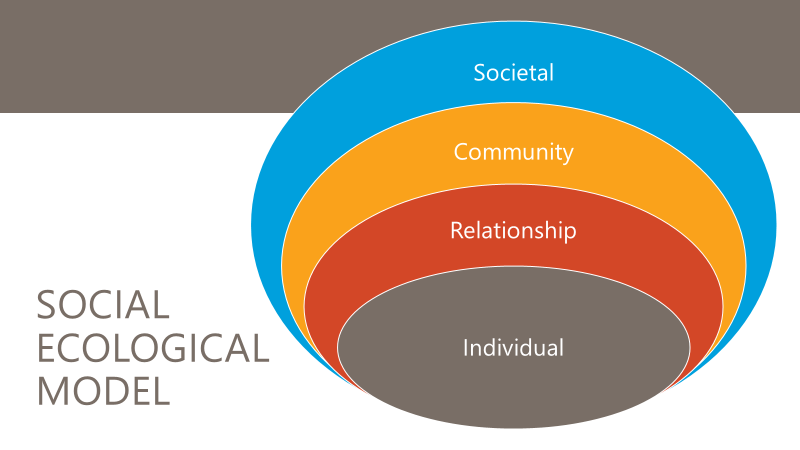Public Health Approach to Primary Prevention
The 4 Step Public Health Approach was developed by the Centers for Disease Control and Prevention (CDC) and takes a multi-disciplinary approach and outlines how to best prevent violence.

The Social-Ecological Model provides a framework for prevention that demonstrates the four levels of society that impact violence. The four levels are individual, relationship, community and societal. Each level has factors that interact with those at different levels and an approach that targets multiple levels is more likely to have a sustained impact.

Individual -The inner level identifies biological and personal history factors that increase the likelihood of becoming a victim or perpetrator of violence.
Relationship - The second level examines close relationships, including a person’s peers, partners, and family members, that may increase the risk of experiencing violence as a victim or perpetrator.
Community - The third level explores local settings and aims to identify characteristics associated with becoming victims or perpetrators of violence. Settings include neighborhoods, schools, and workplaces.
Societal - The outer level looks at broad societal factors that help create a level of acceptance or intolerance for violence. It also includes the health, economic, educational and social policies that help to maintain economic or social inequalities between groups in society.
What Are Risk and Protective Factors?
Risk Factors are conditions or characteristics that increase the likelihood of sexual and domestic violence perpetration and victimization. Risk factors do not necessarily directly cause sexual and domestic violence, but their presence increases the chance of perpetration and victimization. Risk factors can be characteristics of an individual or conditions present in the environment. Risk factors can be used to help focus prevention efforts.
Protective Factors are conditions or characteristics that decrease the likelihood of sexual and domestic violence perpetration and victimization, while also facilitating a broad range of related positive outcomes. A single protective factor does not necessarily directly prevent sexual and domestic violence, but the presence of multiple protective factors decreases the chance of perpetration and victimization. Protective factors can be characteristics of an individual or conditions present in the environment.
| Examples of Risk and Protective Factors That Contribute to IPV and SV | ||
| Risk Factors | Protective Factors | |
| Individual |
|
|
| Relationship |
|
|
| Community |
|
|
| Societal |
|
|
The Centers for Disease Control and Prevention (CDC) has a more comprehensive list of risk and protective factors related to violence perpetration.
- Sexual Violence Risk and Protective Factors for Perpetration
- Intimate Partner Violence: Risk and Protective Factors for Perpetration
Shared Risk and Protective Factors
Across Multiple Forms of Violence
Many forms of violence share the same root causes or risk and
protective factors. Recently more resources have become available to
assist organizations in identifying opportunities to coordinate and
collaborate across various types of violence prevention work.
Connecting the Dots: An Overview of the Links Among Multiple Forms of
Violence
This document from CDC shows the connections between different forms of
violence at all of the levels of the SEM. The document can assist
organizations in thinking strategically in partnering for prevention
work.
This document from the National Sexual Violence Resource Center shows connections between risk and protective factors and social determinants of health at the various levels of the social ecology, and can be used to link sexual violence prevention with anti-oppression and related public health issues in order to create more effective change.
